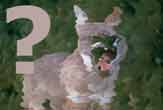In Killing Chupacabra, Did Teen Commit a Felony?

A Texas boy killed what he claims is the legendary vampire beast "el chupacabra" last weekend. Carter Pope (also identified as Carter Sinclair), 13, shot the animal three times on Sunday near his home in La Salle, Texas. He saw the four-legged, doglike animal walking across an open field, but it didn't look exactly like a dog: "It had no hair at all on it," he told local media. "Its back legs were shriveled up. I honestly think it's a chupacabra."
Pope is eagerly awaiting confirmation of his historic chupacabra find through DNA analysis of tissues his father sent to a lab. If history is any guide, the chupacabra — which means "goat sucker" in Spanish and is named for its reputed habit of sucking the blood out of small animals, including goats and chickens — will soon be revealed as a known member of the canid family, a group that includes dogs, coyotes and foxes. (The creature Pope shot was not seen, nor suspected of, sucking blood out of anything; it was merely walking across a field.)
Previous "chupacabras" killed or found in Texas have all been identified as known animals, including domestic dogs, coyotes and even a raccoon. Many of the animals get their hairless (or nearly hairless) look from a common skin disease called sarcoptic mange, caused by mites. Other animals may be hairless because of a genetic defect. Then there's the Xolo dog, a hairless breed from Mexico that has occasionally sparked chupacabra stories. [Mythical Creatures That Don't Exist (Or Do They?)]
Pope's story has attracted both national and international attention, fueling renewed speculation about the world's No. 3 best-known mystery beast (after Bigfoot and the Loch Ness monster). But the fact that a Texas teen shot and killed a mangy dog or coyote is perhaps less interesting than the question of why he thought it was dreaded chupacabra in the first place — and what type of trouble he might have gotten himself into.
The chupacabra myth only dates back to 1995, when an eyewitness sighted the monster in Puerto Rico. Later research, published in my book "Tracking the Chupacabra," showed that the original chupacabra report was not real, and instead described a monster in a science fiction film. Since then, no hard evidence of the beast has emerged, and the story has been kept alive by occasional feral, hairless canids such as the one Pope shot — even though they look nothing like the original description. [El Chupacabra Mystery Solved: Case of Mistaken Identity]
Ironically, Carter Pope may end up getting in trouble with animal rights advocates — or even the law. Pope, a minor, presumably had his parents' written permission to carry the rifle he used as required by Texas law. But just because a person sees an animal he or she doesn't recognize doesn't necessarily mean they have the right to shoot and kill it on a whim. The animal was not attacking anyone or anything, nor being a nuisance.
And while the creature was probably a feral dog or coyote, it could be a neighbor's missing, sick pet. If the animal turns out to be a dog, Pope could potentially be charged with a felony. Texas Penal Code 42.09 on animal cruelty states a person who "kills, seriously injures, or administers poison to an animal, other than cattle, horses, sheep, swine, or goats, belonging to another without legal authority or the owner's effective consent," could be charged with a felony offense. (The degree of the felony can be upgraded if a person is a repeat offender.)
Get the world’s most fascinating discoveries delivered straight to your inbox.
A clue as to why the boy thought it was a chupacabra in the first place can be found in his father's comment that, "I know it looks like nothing I have ever personally seen before." Pope and his father assumed that if the creature were a known animal, they would recognize it. In fact, the animal looks identical to thousands of mangy dogs and coyotes roaming North America. This is the same logic that UFO believers employ, assuming that any strange light in the sky they can't identify must be an alien spacecraft.
The lesson is that just because you don't recognize something you see doesn't mean it's mysterious (or that you should kill it). That, and shooting a dog or coyote will make international news if you call it a chupacabra.
This story was provided by Life's Little Mysteries, a sister site to LiveScience. Follow Life's Little Mysteries on Twitter @llmysteries, then join us on Facebook.
Benjamin Radford is deputy editor of Skeptical Inquirer science magazine and author of Tracking the Chupacabra: The Vampire Beast in Fact, Fiction, and Folklore. His website is www.BenjaminRadford.com.



